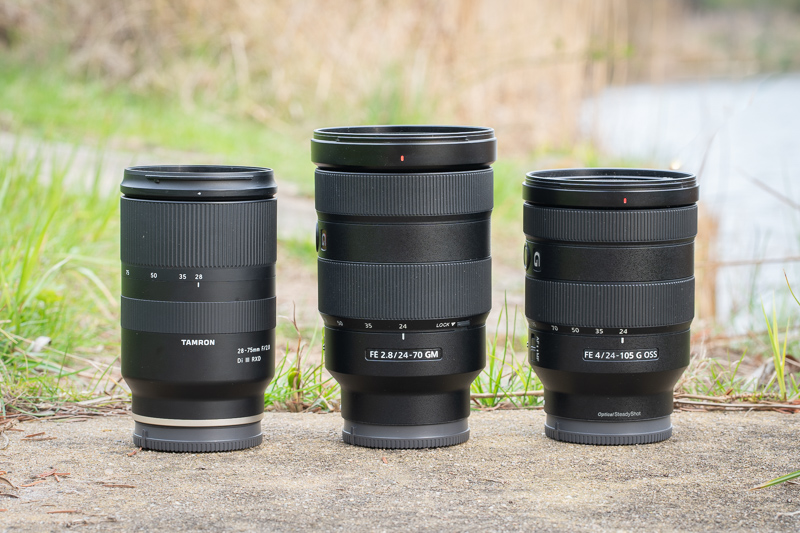
Standard zooms are the swiss knifes for photographers who need flexibility, can’t change lenses or prefer exact framing over prime qualities.
The Sony FE standard zoom palette has grown in the past years. In the beginning, we were cought between a rock (Sony FE 3.5-5.6/28-70) and a hard place (Sony FE 4/24-70 ZA OSS). We were trying to get around this lens type as good as we could.
In 2019, three great options are available and the situation is the other way around. Not only I have a hard time to decide which of the three highly regarded lenses suits me best, so let’s find out together which lens is the best choice for whom.
This article will be split into three seperate posts due to the sheer amount of information. I will start with a sharpness shootout (infinity) between the Sony 2.8/24-70 GM, the Tamron 2.8/28-75 Di III RXD and the Sony 4/24-105 G OSS.
Introduction
First of all, let me quote Roger Cicala from Lensrentals.com who said this in the fredmiranda.com forum. He probably tested more lenses for sample variation than all readers of this post together:
“I’ve only tested 5,000 zooms so far so all I can say is the frequency of a zoom perfect at all focal lengths is lower than 1 in 5,000.”
So after all, you see just the performance of my copies of these lenses. Those who know me will agree that I am very picky about my lenses so expect my copies to be rather better than worse. Nevertheless, there will be samples that could perform differently. This also applies for every other review on the web but is especially true for a comparison of three zoom lenses.
This article is obviously very geeky as it compares the sharpness around the infinity mark in detail at different focal lengths and areas of the frame. That’s why I will start with the..
Summary
For those who don’t want to look at all images in detail, I’ve created this table. I’ve rated the lenses in all analyzed categories. 1 stands for the best performer, 3 for the weakest.
| Focal Length / Area | Sony 2.8/24-70 GM | Tamron 2.8/28-75 DiIII RXD | Sony 4/24-105 G OSS |
|---|---|---|---|
| 24/28mm / center | 1 | 2 | 3 |
| 24/28mm / midframe | 3 | 1 | 2 |
| 24/28mm / corner | 1 | 3 | 2 |
| 35mm / center | 3 | 1 | 2 |
| 35mm / midframe | 1 | 2 | 3 |
| 35mm / corner | 2 | 3 | 1 |
| 50mm / center | 1 | 2 | 3 |
| 50mm / midframe | 1 | 3 | 2 |
| 50mm / corner | 1 | 3 | 2 |
| 70/75mm / center | 1 | 2 | 3 |
| 70/75mm / midframe | 1 | 2 | 3 |
| 70/75mm / corner | 1 | 3 | 2 |
It’s easily visible that my copy of the 2.8/24-70 GM lens stands out of the crowd in terms of sharpness. Especially at the long end, it resolves generally a bit more detail than the rest. The weaknesses of the GM are a mid zone dip at 24mm and a slightly worse performance at 35mm. This behavior also matches with another copy of this lens that I have tested a while ago.
This said, the other lenses are no slouches at all. Generally, the Tamron 2.8/28-75 is a bit sharper than the Sony 4/24-105 in the center while the latter is more constant across the frame which fits also well to their applications.
Interestingly, the Tamron renders a bit warmer than both Sony lenses which have roughly the same color/contrast footprint.
In my opinion, we see three very good performances and none of these lenses should be ruled out just by this shootout. The other categories of performance (especially bokeh) and the general specs of the lenses can be very important for a buying decision and will be discussed in the next articles.
The Sony 2.8/24-70 GM can be bought for $2.198 at Amazon.com (affiliate link), 2.199€ at Amazon.de (affiliate link). Sometimes used copies are available at Ebay.de or Ebay.com (afiliate links).
The Tamron 2.8/28-75 Di III RXD can be purchased for $899 at Amazon.com (affiliate link) or 829€ at Amazon.de (affiliate link). Sometimes you can get a used lens or a good deal at Ebay.de or Ebay.com (affiliate links).
The Sony 4/24-105 G OSS can be bought for $1.398 at Amazon.com (affiliate link), 1.398€ at Amazon.de (affiliate link). Sometimes used copies are available at Ebay.de or Ebay.com (afiliate links).
Aperture Series (infinity sharpness)
24/28mm:
- Center: Sony 2.8/24-70 GM has a small advantage over the Tamron 2.8/28-75 in terms of contrast and sharpness. Both lenses are excellent and a bit better than the 4/24-105G
- Midframe: The Tamron 2.8/28-75 and the Sony 4/24-105 are very good at apertures below f/8, the GM lacks in contrast at these apertures. At f/8, all lenses are almost equal.
- Corner: The Sony 2.8/24-70 GM resolves more details than the other two lenses at all apertures. The other two lenses are very close and also not bad at all.


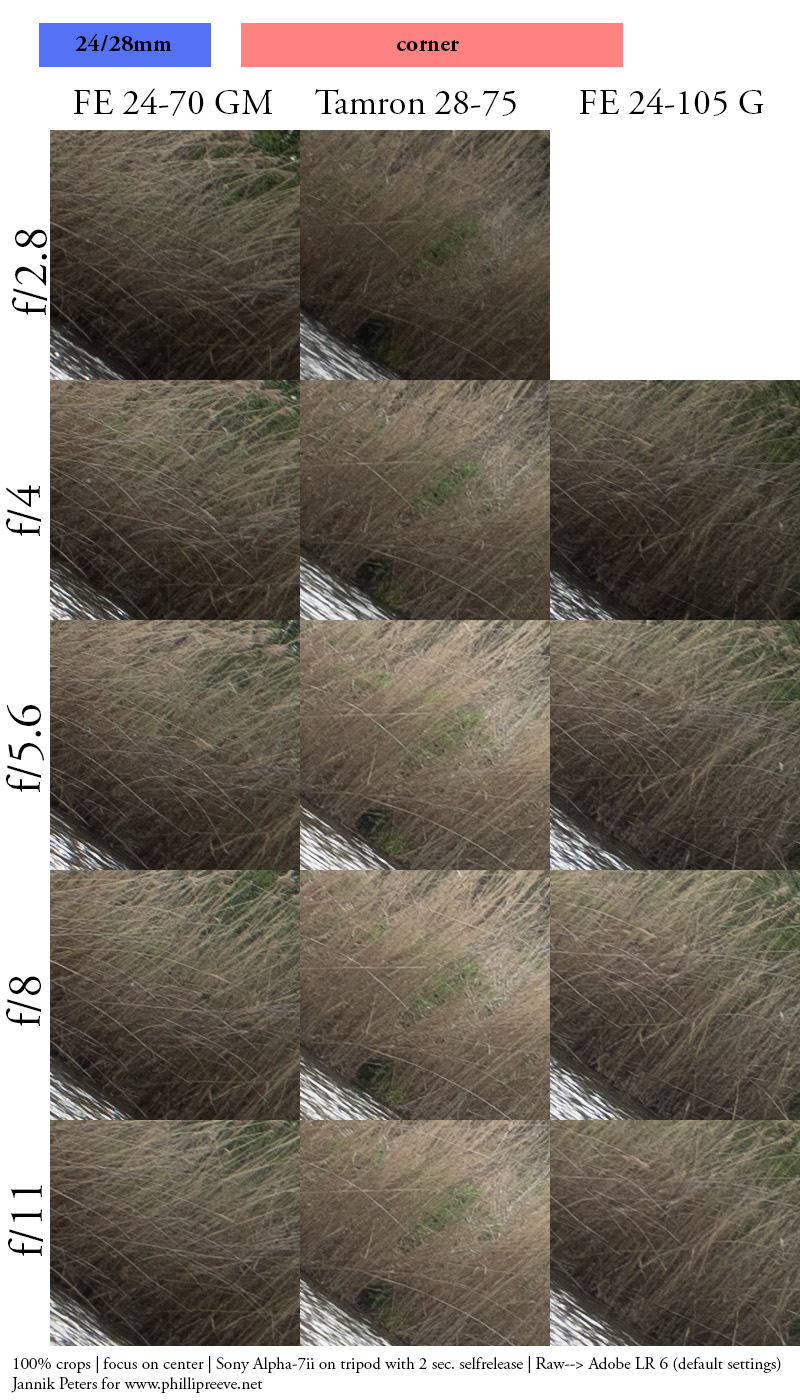
35mm:
- Center:The Sony 2.8/24-70 GM looks less crispy at wide apertures, the Tamron 2.8/28-75 really shines there and is also a tad better than the very good Sony 4/24-105 G
- Midframe: The Sony 2.8/24-70 GM is visibly better than the other two lenses, the Tamron follows and the Sony 4/24-105 G resolves less fine detail
- Corner: The Sony 2.8/24-70 GM and the Sony 4/24-105 G are very good at f/8, the latter is a bit better wide open and is the best lens here. The Tamron 2.8/28-75 is quite a bit worse here and needs f/8 for good corners

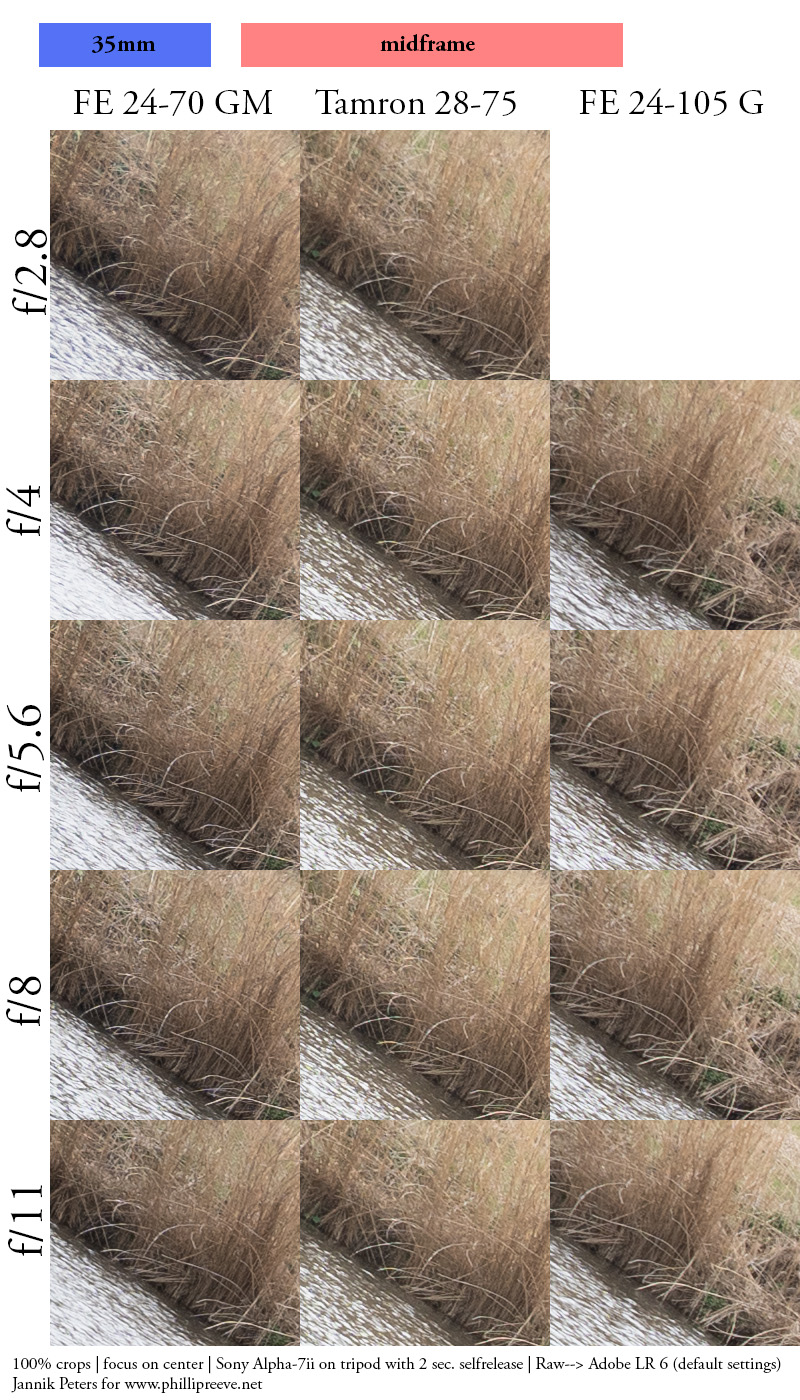

50mm:
- Center: The Sony 2.8/24-70 GM is razor sharp here, there is even a tad of diffraction visible at f/5.6. The Tamron 2.8/28-75 is also very good in the center, the biggest difference to the GM is visible at f/2.8. The Sony 4/24-105 is also very good but lacks a bit in edge acuity compared to the other two.
- Midframe: The GM clearly wins by a bit and offers great sharpness, the Sony 4/24-105 follows and the 2.8/28-75 is the weakest but improves until f/11
- Corner: The Tamrom 2.8/28-75 shows high astigmatism wide open but resolves more detail at smaller apertures while the Sony 4/24-105 is much better at larger apertures. The Sony 2.8/24-70 GM is once more clearly the best and excellent at f/8.
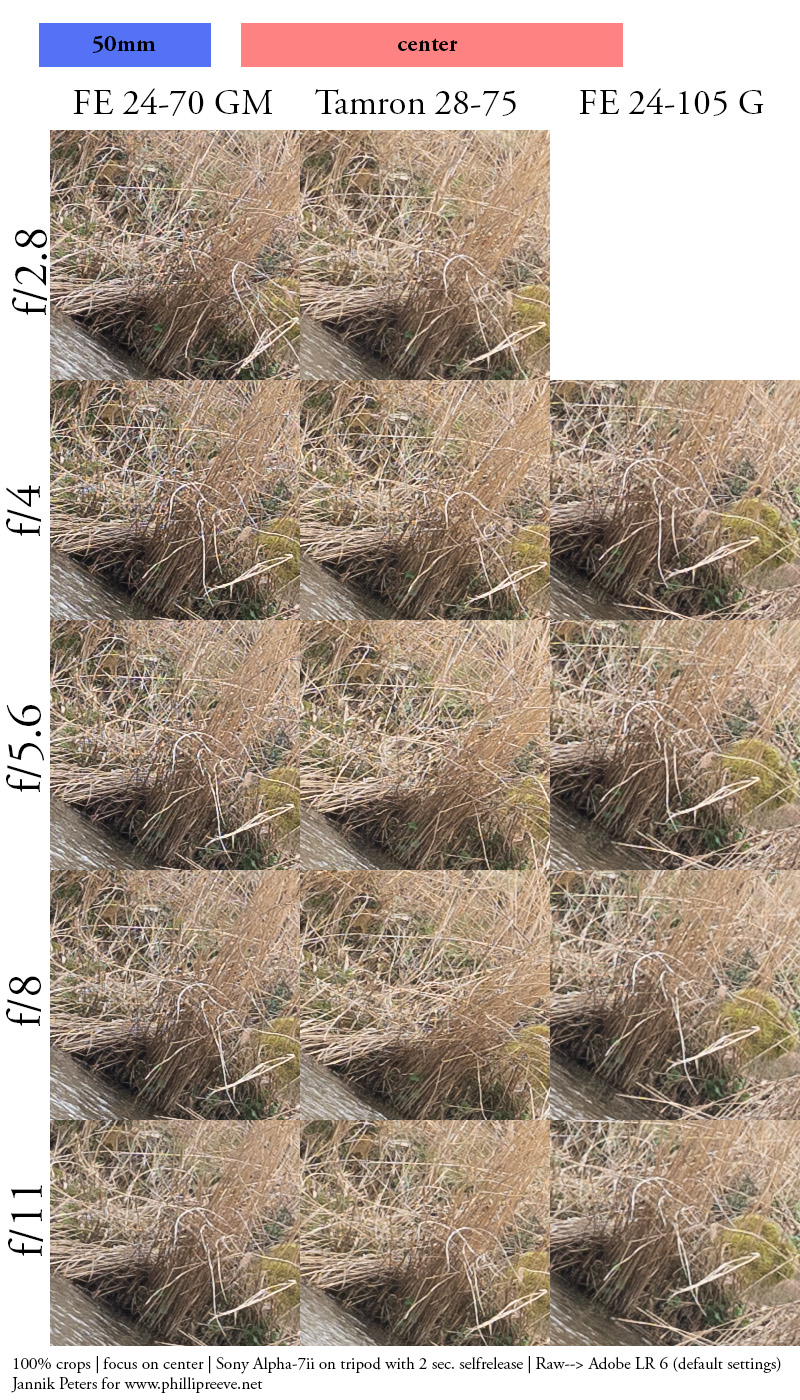
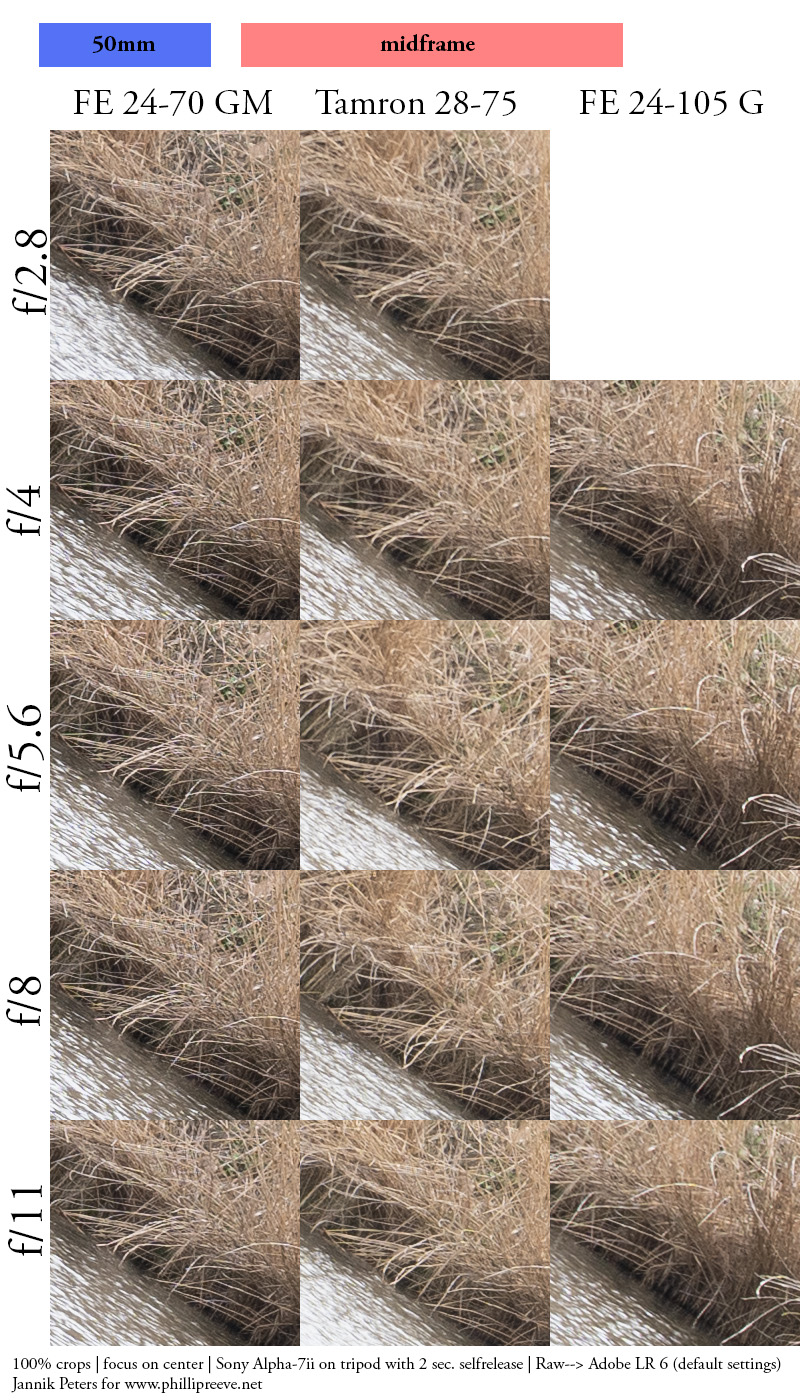

70/75mm:
- Center: Once more, the Sony 2.8/24-70 is visibly better than the other two lenses, followed by the Tamron and the Sony 4/24-105 G
- Midframe: In this area, all lenses are very good. The Sony 2.8/24-70 GM has a small advantage, followed by the Tamron 2.8/28-75 and the Sony 4/24-105 G
- Corner: Surprisingly, all lenses are better than their reputation at the long end. They can use two or three stops down for best corner sharpness, the GM is a bit better than the other two lenses stopped down

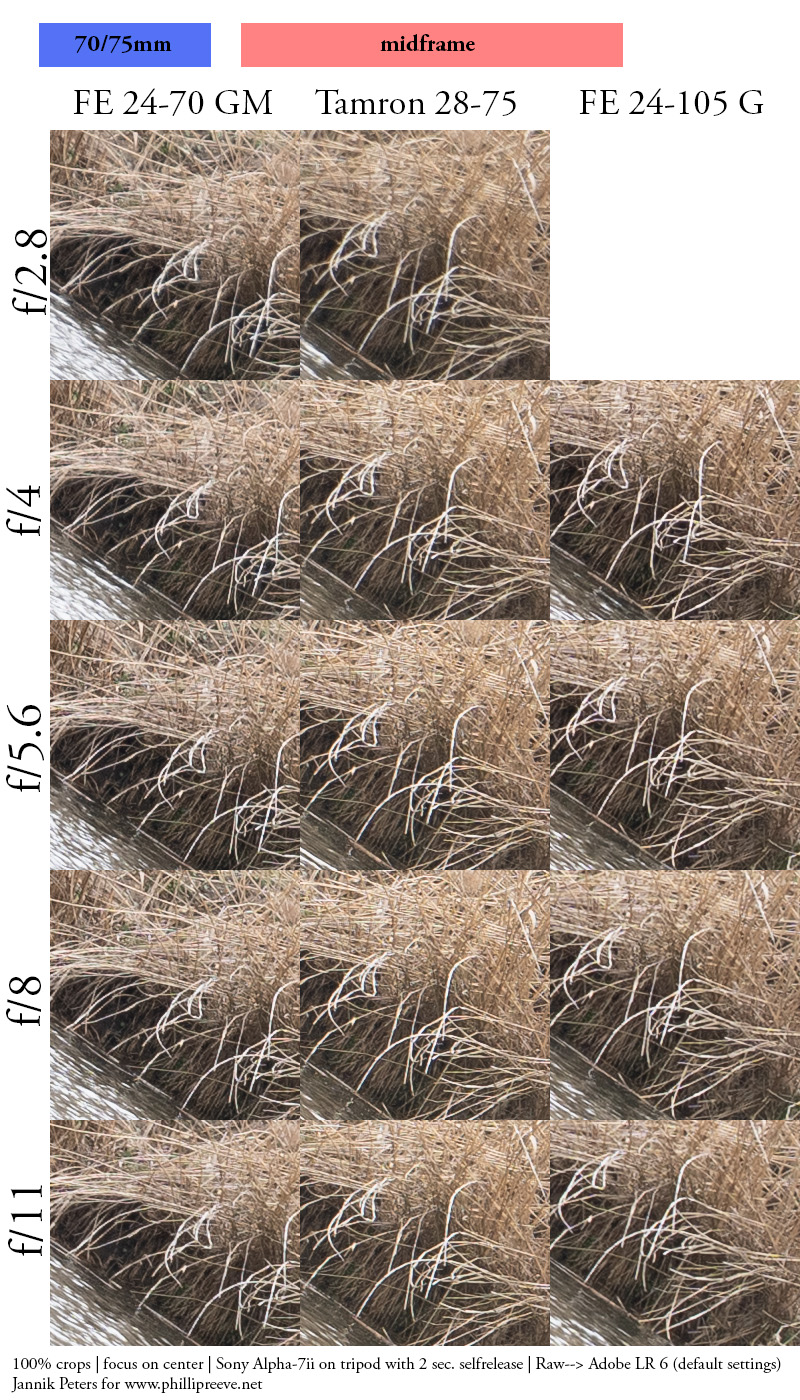

Bonus: 105mm: This is what makes the Sony 4/24-105 G stand out of the crowd. The central performance is already good wide open and best at f/5.6. Midframe and corner are sharpest at f/8, the image is good across the frame there.
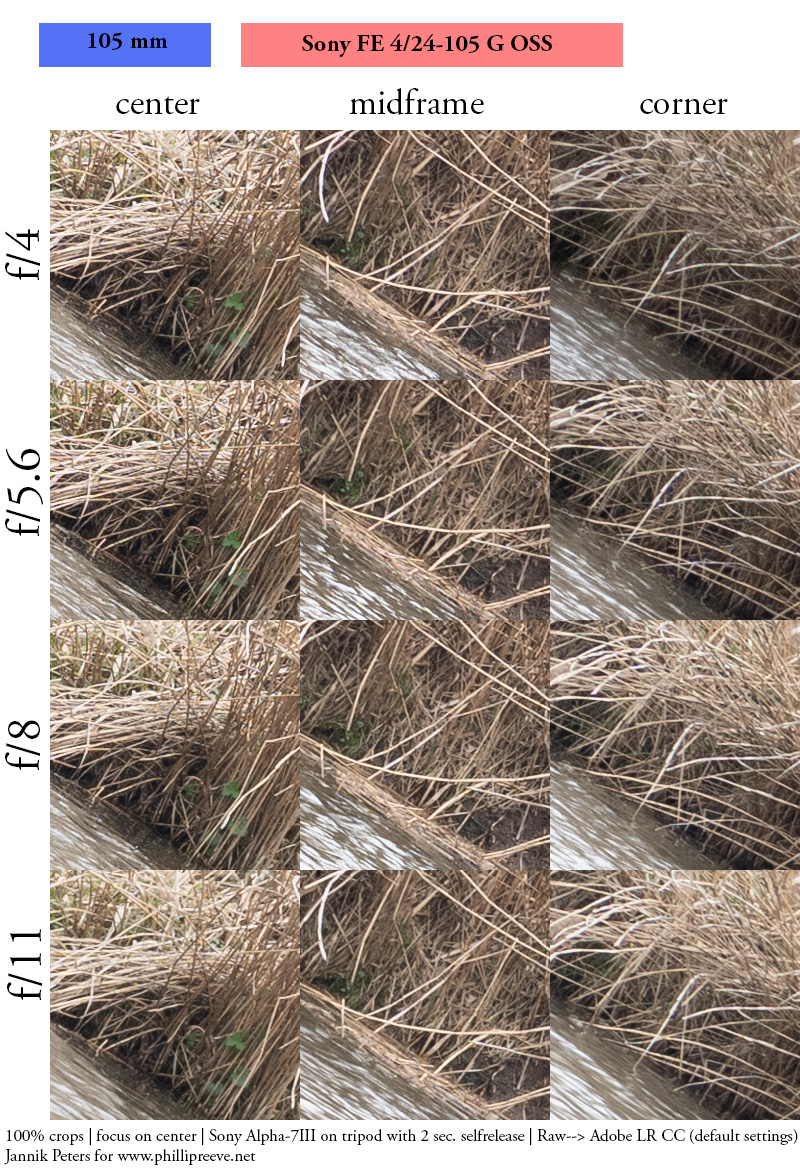
Part 2 (bokeh) will follow!
Obviously, this shootout is quite a bit of work. You can valuate that if you buy your gear using one of these affiliate links:
The Sony 2.8/24-70 GM can be bought for $2.198 at Amazon.com (affiliate link), 2.199€ at Amazon.de (affiliate link).
The Tamron 2.8/28-75 Di III RXD can be purchased for $899 at Amazon.com (affiliate link) or 829€ at Amazon.de (affiliate link).
The Sony 4/24-105 G OSS can be bought for $1.398 at Amazon.com (affiliate link), 1.398€ at Amazon.de (affiliate link).
Continue with Part 2: Macro capabilities
This site contains affiliate links. If you make a purchase using any of the links marked as affiliate links, I may receive a small commission at no additional cost to you. This helps support the creation of future content.
Jannik Peters
Latest posts by Jannik Peters (see all)
- A beginner’s guide to bird photography – Episode 1: Sharpening your senses - August 3, 2021
- Review: Tamron 35mm F/2.8 Di III OSD M1:2 - March 8, 2020
- Review: Zeiss Batis 2/40 CF after the Firmware Update - August 16, 2019
You where reading my mind! I’m right now deciding between the 24-105 and the 28-75 so this post comes at the right time. Wishing to see the rest of this series 🙂
PS: Comparing the long end of these lenses with the 85mm f1.8, for portraits usage, would be phenomenal!
I am also looking forward to continue this shootout. Maybe the GM 1.8/135 will come between a soon continuation of the series but I will try my best.
I can compare it to my 1.8/85 once I setup a portrait scenario.
I second this!
Unfortunately in my country the 24-105G is 2 times (actually a bit more) more expensive than Tamron 28-75. Which makes it a bit less reasonable choice than in US or EU markets.
It’s not an easy choice, not even for me as I have all three lenses here and still can’t decide which I will sell after the review – Jannik
Tamron interesting but he doesn’t need me in the trip 24mm and I don’t need aperture. It would be interesting to see a comparison with Canon EF zooms that can be put on a Sony through an adapter. He purchased the EF 24-105 STM, but I have no way to test with other zoom lenses.
thanks alot for your effort, i greatly appreciate it, as comparisons are hard work and alot less enjoyable.
Thanks a lot, you are so right 😉 – Jannik
lot of copy variation on the lenses though. i have two sony 24 105 and there is visible variation (center and corners) between the two. you can test 3 copies of the lens and it will look like 3 different lenses. Same goes with the sony 24 70. Don’t know if also the Tamrons have such a variation.
No doubt, that is true for every zoom lens and expected. That is why I wrote the introduction above it 🙂
This is just amazing zoom shootout i really liked it…thanks you so much for sharing!
Thank you for the tests. For me it validates the idea that the Tamron is a tremendously good value. I see it as very competitive in these images despite being far cheaper and lighter than the Sony. The differences you document really aren’t that big to me as someone who doesn’t pixel peep much.
Personally I think many photographers now put too much weight on 100% crops of high resolution images. I think the search for pixel peeping perfection is part of the reason why we have ever heavier and more expensive lenses and for me at least, small sharpness differences between good lenses, don’t make that much of a difference when it comes to whether or not an image is good. Things like rendering, light, composition, subject matter, talent, etc make much more of a difference. To be honest I don’t really find work from today on today’s ultra high resolution cameras with the best of modern lenses any more compelling than what the best photographers were putting out ten years ago. Yes things may be sharper, noise may be lower, you might be able to make a better gigantic print or heavy crop etc but in terms of whether or not the image is impactful to me, I really don’t find the work today to be any more impressive than what great photographers were doing a decade ago. I doubt that I’ll be more impressed by what people will be doing with 100mp sensors. Sure the images may technically be better but I don’t think they will necessarily be any more compelling in most cases.
I agree with your column a few months ago wanting more smaller, slower, and/or less perfect lenses.
so from sharpness it seems the tamron is the best choice,
im looking forward to the bokeh test, i’m wondering what part 3 will be about, handling/buildquality?
…that is in terms of price/performance
Very interesting test, thanks a lot 🙂 My personal expericence is totally different here. I compared the SEL2470GM and the SEL24105G – and the G was sharper outside Center, and Shows very goog sharpness in the whole zoom range; so I decided to buy the G, which was little decentered, but Schuhmann (Herr Mayr) could fix it.
Thank you, Wolfgang! Your comment is much appreciated as it points out once more that copy variance is a huge factor here. I think my 24-105 performs good in peripheral areas but my GM is just really good there (it was also fixed by Schuhmann after sub-par centering)
Who is Schumann..? I would like to have mine centered too.
Sony Service center in Austria.
This doesn’t match my findings, I had the GM, but sold it when I got the 24-105 as it was sharper in most areas, especially at 70mm where the 24-105 was miles ahead of the GM.
exactly,i think it is not so interesting to compare lenses that are known to have a lot of sample variation. My two copies of the
G 24 105 are so different that in some aspects they almost look like two different lenses.
I think one issue is the RAW conversion can treat different lenses differently. It seems to me that it is just applying less sharpening to the 24-105 across the board. Compare the images at f/11, for example, where lens differences should be almost zero.
Definitely interesting, I noticed that too. But I think my methodology isn’t wrong as this is what the user will face (at least in Lightroom). Maybe the lenses diffract differently as well although I don’t know to which level this is possible.
why only test sharpness; it’s like testing the maximum speed of cars. I don’t have the sharpest lenses but I have the one with the nicest image quality…
Please read the text.
They said it was part one of their test.
Jannik,
Since all these lenses are of similar caliber mostly, won’t it be a good idea to benchmark them against a supposedly weak lens like 28-70 kit lens. That will tell me that at F8, where and what exactly a buyer is getting. Normally the benchmarking is done against the “best”.
For record,
The overall and the sharpness scores of 24-70 GM vs FE 28-70 on a7R2 are, 33 vs 28 and 28 vs 25.
Not a huge difference.
So basically you are paying for build (and size !) bokeh and Fstop and yes wide open sharpness.
Sharpness at F8 won’t be a day and night difference.
I love the Tamron. The price vs performance is unbeatable. I used my uncle’s 16-35GM for a good while before i bought the Tamron, and I saw nothing about it to justify the significant extra cost.
Interesting comparison. I don’t know if you have experience with the Contax Yashica Vario-Sonnar T* 3.4/35-70 stadardish zoom? It would be interesting to get a sense of how far optics, coatings and ergonomics have cone since 1982, when that standard zoom was designed. The Contax zoom has quite a cult following, much like the Vario-Sonnar T* 4.5-5.6/100-300 that you reviewed recently, and many still swear by it and dare compare it to current standard zooms. These comparisons are certainly a bit forced, but they raise the interesting question of how much better todays 24-70s are.
Cheers!
I would second this request. I have used the Contax 35-70 happily for many years (since the film era). But it would be good to have AF and EXIF info sometimes — as well as easier coupling with the Sony image stabilizer system. Are these worth the extra cost — maybe not quite yet. But your input might tip the scales for me (at least vs a vs the Tamron — which is attractive to me from a size/weight/price perspective).
I owned and used the CY 35-70 for a good while.
I think this are the differences and the reason why the CY doesn’t fit too well into the comparison:
– No AF
– No EXIF
– Awkward handling (Push/Pull combined with no EXIF for IBIS)
– Strong field curvature at 35mm
– More limited zoom range
Despite of that, the CY 35-70 is a very good lens and could hold up well in that comparison at 50mm and 70mm.
It just feels dated, especially with the more advanced Sony bodies. I was actually happy to sell it for the Tamron which got much more use in real life than the Contax.
There is not only sharpness in life. Not only my 28/70 has sharpness problems in the low range , it has clearly a mediocre performance in term of contrast and colours. Its rendition can be qualified as muted compared for example with the 24/70 f4.
Thanks for your detailed answer, Jannik.
You are of course right about AF, EXIF data, having to manually dial in FL for IBIS, the push-pull zoom mechanism.
For me, personally, the autofocus adds no value and I have been able to shoot with it at the same keeper rate as my more recent MF lenses – like Loxias and CV lenses – without critical need for IBIS. I could complain about EXIF data, but it doesn’t affect image quality. The push-pull mechanism is perhaps the most difficult aspect to justify and get used to, especially with no FL data in the EVF.
Where I don’t agree, though, is regarding the pronounced field curvature at 35mm. This is of course not uncommon in other Zeiss 35mm lenses, but I believe the C/Y 35-70 is by far not the worst offender in this respect.
I agree that image quality, despite some shortcomings compared to more recent glass, holds up very well. My experience, having only owned the a7RIII, is that it gives great results on the Sony 42mpx sensor, but I have not much to compare it with. I sold my 16-35 GM, which is better than its reputation at 35mm, and I don’t miss it. The user experience is certainly not the most enjoyable, though. Long and heavy adapter, push-pull zooming are not great. The “makro” feature is what feels most dated, but I really appreciate the generous focus throw.
I wonder how the 35-70 formula would perform with new coatings and zoom ring. Wishful thinking, lol.
Cheers!
Tamron 28-75 is a good lens, but extra reach of Sony 24-105 and faster autofocus is quite tempting. I’m happy with my 28-75, but the grass is greener 😉
Thanks for sharing your test results, Jannik. I can feel the pain and patience behind the results.
I have both the Tamron 28-75 and the Sony 24015/4. Both are excellent lenses. I previously owned the Sony 24-70GM as well. While that lens is outstanding, it’s size and weight made me change initially to the 24-105/4. What intrigued me to buy the Tamron is its close focusing distance. However, while faster than the Sony, I sometimes miss the reach of the 24-105mm. As Jannik says, these are all excellent lenses and owning anyone of these lenses will make the owner happy.
Great review as always.
I have had the 24-70 GM for 3 years and it continues to surprise me by how it keeps up with my top primes despite comments I read denigrating it. The long end is excellent apart from wide open edges and I agree with you that the lens’s main weakness is at 35mm where my testing shows it to have quite a bit of field curvature. Mine, however, is superb in the centre but in practical use the field curvature is often not so noticeable since closer focussing towards the edges is often not a bad thing. It is undeniably large though!
i wonder, is there gonna be a part 3 sometime?
open points for me:
– AF-performance: i think the tamron is not a very good performer at least not on my a7ii, is it faster on a7iii?. The sonys will probably be faster, compared to the 2470z the tamron is significantly slower also in dim light.
– Bokeh, in comparison, i guess really not a strength of the Tamron, i wonder if the faster speed compared to the 24105 will be at all benefical here for portraits.
Nice work Jannik. Thank you.
For me the real question is are these minor changes in focus between these 3 lenses are necessary to buy a more expensive lens.
I will explain my self. These days one can buy a 40-60 megapixel camera. Not all of us needs so many pixels all the time. I usually post my photos in Instagram or facebook with much lower resolution. Even printing 20×30 cm print I rarely do, doesnt need all these pixels.
I use photoshop to get more sharpness in image processing. I havent done the following experiment, maybe someone else did or Jannik will try it for us: taking photos at 40-60 MP, sharpening in LR or PS and lowering resulotion to 20-30 MP. And then check how much there is a difference between Tamron and sony 24-70 f/2.8.
Jannik : What do you think of the Sigma 24-70 DG DN art ? Do you think it would be a resonabe alternative / replacement for primes to an enthusiast ?
Just did a comparison of the following lenses using MTF mapper. Sony 24-70mm GM; 24-105mm G x2 copies; 28-70mm. At 70mm, the GM is the winner. The G’s are no better than the 28-70. As for sample variation, the G’s were purchased on ebay from different parts of the country…but likely made at the same plant in Thailand. The variation between the G’s was miniscule. The MTF curves were very close…and it’s not like they were all that uninteresting. They had some weird swoops…but they both were still close.